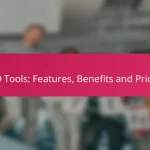Understanding the various blog types and their unique benefits is essential for content creators looking to enhance reader engagement and drive traffic. Formats such as listicles, how-to guides, and opinion pieces can attract diverse audiences and encourage interaction. By implementing strategic keyword research and effective content promotion, bloggers can significantly boost their visibility and foster a thriving community around their content.

What are the most effective blog types for engagement in Canada?
In Canada, the most effective blog types for engagement include listicles, how-to guides, case studies, interviews, and opinion pieces. Each format offers unique benefits that can attract readers and encourage interaction, making them valuable tools for content creators aiming to boost engagement.
Listicles
Listicles are popular for their easy-to-digest format, presenting information in a structured way that appeals to readers’ preferences for quick insights. They typically feature numbered or bullet points, making it simple for readers to scan and find relevant information.
To create an engaging listicle, focus on a specific topic relevant to your audience. For example, “10 Must-Visit Canadian Destinations” can attract travel enthusiasts. Ensure each item is concise and provides value, enhancing the likelihood of shares and comments.
How-to guides
How-to guides are effective for providing step-by-step instructions on specific tasks, making them highly valuable for readers seeking practical solutions. These guides can cover a wide range of topics, from DIY projects to digital marketing strategies.
When crafting a how-to guide, start with a clear introduction that outlines what the reader will learn. Use simple language and include visuals or screenshots to enhance understanding. For instance, “How to Start a Small Business in Canada” can guide aspiring entrepreneurs through essential steps.
Case studies
Case studies showcase real-life examples of success or failure, providing insights that resonate with readers. They are particularly effective in demonstrating the application of theories or strategies in practical scenarios.
To write a compelling case study, select a relevant subject and detail the challenges faced, the actions taken, and the outcomes achieved. For instance, a case study on a Canadian startup’s journey can illustrate key lessons for other entrepreneurs. Ensure to include data and testimonials to enhance credibility.
Interviews
Interviews can engage readers by offering unique perspectives from industry experts or influencers. They provide valuable insights and foster a sense of connection between the audience and the interviewee.
When conducting interviews, prepare thoughtful questions that encourage detailed responses. Highlight key takeaways in your blog post, such as “Insights from Canadian Tech Leaders,” to attract readers interested in industry trends and personal stories.
Opinion pieces
Opinion pieces allow writers to express their views on current events or industry trends, encouraging discussion and engagement among readers. These articles can provoke thought and invite differing perspectives.
To write an effective opinion piece, clearly articulate your stance and support it with evidence or examples. For instance, discussing the impact of climate change policies in Canada can resonate with environmentally conscious readers. Encourage comments to foster dialogue and engagement.

How do blog types influence traffic generation?
Different blog types can significantly impact traffic generation by attracting diverse audiences and engagement levels. Understanding how each type operates allows bloggers to tailor their content strategies effectively.
SEO optimization
SEO optimization is crucial for driving organic traffic to blogs. By using targeted keywords, optimizing meta tags, and ensuring mobile-friendliness, bloggers can enhance their visibility on search engines. For instance, long-form content that answers specific questions often ranks better than shorter posts.
Consider using tools like Google Analytics and SEMrush to identify high-traffic keywords relevant to your niche. Regularly updating content and focusing on backlinks can also improve search rankings.
Social media sharing
Social media sharing can dramatically increase a blog’s reach and visibility. By creating shareable content, such as infographics or engaging videos, bloggers can encourage readers to distribute their posts across platforms like Facebook, Twitter, and Instagram.
Utilizing social media buttons on blog posts makes sharing easier. Engaging with followers and participating in relevant conversations can further boost traffic from these channels.
Email marketing
Email marketing remains a powerful tool for driving traffic to blogs. By building a subscriber list and sending regular newsletters, bloggers can keep their audience informed about new posts and updates. Personalized emails often yield higher open rates and engagement.
Incorporate clear calls-to-action in your emails, directing readers to your latest content. Segmenting your audience based on interests can also enhance the effectiveness of your campaigns, leading to increased traffic over time.

What are the best practices for driving traffic to blogs?
To effectively drive traffic to blogs, focus on strategic keyword research, robust content promotion, and engaging guest blogging. These practices enhance visibility, attract readers, and foster community engagement.
Keyword research
Keyword research is essential for understanding what your target audience is searching for. Use tools like Google Keyword Planner or SEMrush to identify relevant keywords and phrases that align with your blog’s content.
Consider long-tail keywords, which are more specific and often less competitive. For example, instead of targeting “travel,” aim for “budget travel tips for Europe.” This approach can lead to higher conversion rates as it attracts a more focused audience.
Content promotion
Promoting your content is crucial for increasing its reach and driving traffic. Utilize social media platforms, email newsletters, and online communities to share your blog posts. Tailor your message for each platform to maximize engagement.
Consider using paid advertising options like Facebook Ads or Google Ads to boost visibility. Set a budget that aligns with your goals, and monitor performance to adjust your strategy as needed.
Guest blogging
Guest blogging allows you to reach new audiences by contributing content to other blogs in your niche. Identify reputable blogs that accept guest posts and have a similar target audience. This can enhance your credibility and drive traffic back to your site.
When writing guest posts, ensure they are high-quality and provide value to readers. Include a compelling author bio with a link to your blog, and engage with comments to build relationships with the new audience.

How can engagement be measured for blog content?
Engagement for blog content can be measured through various metrics that reflect reader interaction and interest. Key indicators include comments, social media interactions, and time spent on the page, each providing insights into how well the content resonates with the audience.
Comments and feedback
Comments and feedback are direct indicators of reader engagement. They show that readers are not only consuming content but also willing to share their thoughts or ask questions. A blog post that garners a significant number of comments typically indicates a strong connection with its audience.
To encourage comments, consider posing questions at the end of your posts or inviting readers to share their experiences. Monitor the quality of feedback as well; constructive comments can provide valuable insights for future content improvements.
Social media interactions
Social media interactions, such as shares, likes, and retweets, are vital for measuring engagement. These metrics indicate how often readers find your content valuable enough to share with their networks, expanding its reach. A high level of social media interaction often correlates with increased traffic to your blog.
To boost social media engagement, include share buttons on your blog posts and create content that encourages sharing, like infographics or listicles. Track which platforms drive the most engagement to tailor your social media strategy effectively.
Time on page
Time on page measures how long visitors stay on your blog post before navigating away. Longer time spent typically suggests that readers are engaged and finding the content useful. Conversely, a low average time on page may indicate that the content is not meeting reader expectations.
To improve time on page, focus on creating high-quality, in-depth content that addresses your audience’s needs. Use engaging visuals and break up text with subheadings to make it easier to read. Regularly analyze time on page metrics to identify trends and adjust your content strategy accordingly.

What are the key factors for selecting a blog type?
Selecting a blog type hinges on understanding your target audience, defining your content goals, and staying attuned to industry trends. These factors help ensure your blog resonates with readers and achieves its intended purpose.
Target audience
Your target audience is the foundation of your blog type selection. Consider demographics such as age, interests, and location to tailor your content effectively. For instance, a blog aimed at young professionals may focus on career advice and networking tips.
Engagement strategies can vary significantly based on audience preferences. For example, a younger audience might prefer visually-driven content, while an older demographic may appreciate in-depth articles or expert interviews.
Content goals
Clearly defined content goals are crucial when choosing a blog type. Determine whether your primary aim is to inform, entertain, or persuade your audience. For example, a blog focused on product reviews will differ greatly from one that shares personal stories or lifestyle tips.
Establishing measurable objectives, such as increasing website traffic or generating leads, can guide your content strategy. Regularly assess your progress against these goals to ensure your blog remains aligned with your intentions.
Industry trends
Staying updated on industry trends is essential for selecting the right blog type. Research popular topics, emerging formats, and successful competitors to identify what resonates with readers. For instance, video content and podcasts are gaining traction in many sectors.
Adapting your blog to align with these trends can enhance its relevance and appeal. However, be cautious not to chase every trend; focus on those that align with your audience and content goals for sustainable growth.

How do local trends affect blog content in Canada?
Local trends significantly shape blog content in Canada by influencing topics, language, and audience engagement strategies. Bloggers must stay attuned to regional interests and cultural nuances to resonate with their Canadian audience effectively.
Understanding Regional Interests
Regional interests in Canada can vary widely from province to province, reflecting local culture, climate, and economic conditions. For instance, outdoor activities are more popular in British Columbia, while winter sports dominate in Quebec. Identifying these interests helps bloggers tailor their content to meet the expectations of their local readership.
Language and Tone Considerations
Language plays a crucial role in engaging Canadian audiences. While English and French are the official languages, the use of local slang and idioms can enhance relatability. For example, using “toque” instead of “beanie” can resonate more with a Canadian audience. Adapting the tone to reflect local sensibilities fosters a stronger connection with readers.
Leveraging Seasonal Trends
Canada experiences distinct seasonal trends that can influence blog content. For example, during summer, topics related to travel, festivals, and outdoor activities gain traction. In contrast, winter months may see increased interest in holiday content and indoor hobbies. Aligning blog posts with these seasonal shifts can enhance engagement and traffic.
Utilizing Local Events and News
Incorporating local events and news into blog content can drive traffic and engagement. For instance, writing about the Calgary Stampede or the Toronto International Film Festival can attract readers interested in these events. Keeping an eye on local happenings allows bloggers to create timely and relevant content that resonates with their audience.










